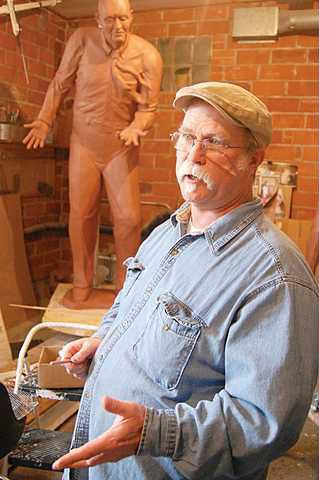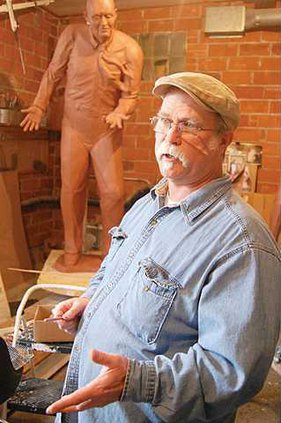This time next year, Nobel Laureate Jack Kilby may be standing in Barton County’s courthouse square.
Great Bend artist Chet Cale has finished three sculptures for a Kilby memorial and plans to deliver them to the Art Casting of Colorado foundry in Loveland, Colo., on Sunday. It will take several months to complete bronze castings that will grace the area, also known as Jack Kilby Square.
Cale was first approached about creating an image of Kilby more than 10 years ago, back when the inventor of the integrated circuit was being considered for a Nobel Prize in physics. Great Bend was Kilby’s boyhood home, and he graduated from Great Bend High School in 1947. In 1958, while working for Texas Instruments in Dallas, he invented a thin wafer of semiconducting material that could contain complex electronic components — the microchip — which is at the heart of today’s computers and other electronic devices.
Kilby was awarded the Nobel Prize in 2000. Private donors raised money for the Kilby memorial, a landscaped plaza with Cale’s sculpture series, titled "The Gift."
"The idea was to create a story," Cale explained. "That’s what I’ve done — the story of The Gift." An 8-foot statue of Kilby shows him handing a gift, representing knowledge and the microchip, to a young boy. The third statue is a girl — perhaps the boy’s younger sister, who appears ready to take the gift and from her brother and run with it to new ideas. Cale says it shows the acceleration of today’s knowledge; Kilby hands his gift to the next generation, but in a short time others from the same generation find new inventions.
Pedestals for the sculptures, lighting and landscaping are already in place on the west side of the courthouse. Cale said people have asked why that work was done so far ahead of the actual statues.
"A lot of construction projects were coming in under budget at the time," he said. He estimates the nonprofit group spearheading the project saved 5 to 10 percent on those costs by doing the work early. The early work will also allow the landscaping to mature before the bronze figures are in place.
The artist worked mainly from photographs to create a lifelike image of Kilby, but he also spent some time in person with the inventor, taking measurements and doing sketches from several angles. Kilby died in 2005. Cale said the sculpture of the boy is based on his late brother, Corby, and the girl is based on his granddaughter Matilda.
Art Castings of Colorado uses the lost wax casting process to cast both bronze and stainless steel sculptures. According to the foundry’s website, "The lost wax process has been used since ancient times and produces exacting, finely detailed reproductions of the original work."
Cale’s work on the project is not yet done. He’ll be in touch with the foundry as staff at Art Castings create the bronze pieces. According to the website, the basic steps are to "make a mold, pour the wax, ‘chase’ the wax, create a ceramic shell, dewax and pour the metal, sandblast the cast metal, weld all the pieces together, chase the metal, apply patina and mount it to a base." A video of this process can be found on the Internet at http://www.artcastings.com/casting-process.html.





